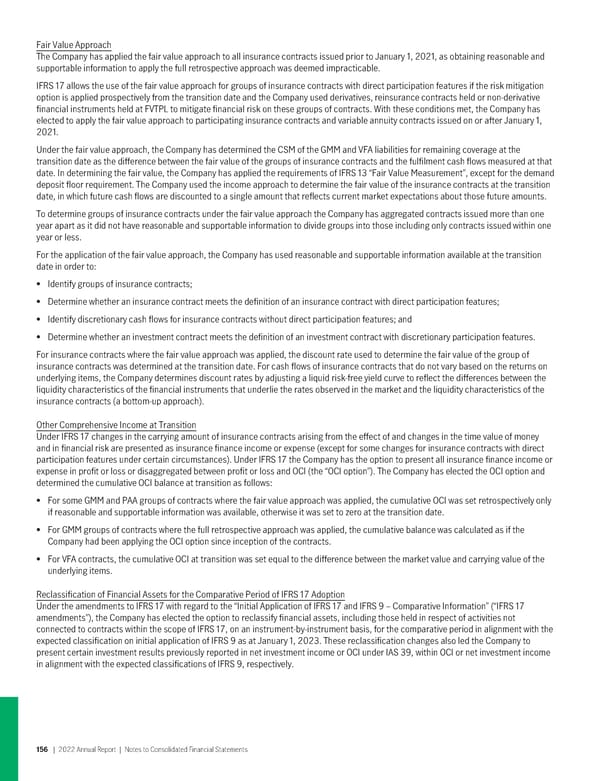Fair Value Approach The Company has applied the fair value approach to all insurance contracts issued prior to January 1, 2021, as obtaining reasonable and supportable information to apply the full retrospective approach was deemed impracticable. IFRS 17 allows the use of the fair value approach for groups of insurance contracts with direct participation features if the risk mitigation option is applied prospectively from the transition date and the Company used derivatives, reinsurance contracts held or non-derivative financial instruments held at FVTPL to mitigate financial risk on these groups of contracts. With these conditions met, the Company has elected to apply the fair value approach to participating insurance contracts and variable annuity contracts issued on or after January 1, 2021. Under the fair value approach, the Company has determined the CSM of the GMM and VFA liabilities for remaining coverage at the transition date as the difference between the fair value of the groups of insurance contracts and the fulfilment cash flows measured at that date. In determining the fair value, the Company has applied the requirements of IFRS 13 “Fair Value Measurement”, except for the demand deposit floor requirement. The Company used the income approach to determine the fair value of the insurance contracts at the transition date, in which future cash flows are discounted to a single amount that reflects current market expectations about those future amounts. To determine groups of insurance contracts under the fair value approach the Company has aggregated contracts issued more than one year apart as it did not have reasonable and supportable information to divide groups into those including only contracts issued within one year or less. For the application of the fair value approach, the Company has used reasonable and supportable information available at the transition date in order to: • Identify groups of insurance contracts; • Determine whether an insurance contract meets the definition of an insurance contract with direct participation features; • Identify discretionary cash flows for insurance contracts without direct participation features; and • Determine whether an investment contract meets the definition of an investment contract with discretionary participation features. For insurance contracts where the fair value approach was applied, the discount rate used to determine the fair value of the group of insurance contracts was determined at the transition date. For cash flows of insurance contracts that do not vary based on the returns on underlying items, the Company determines discount rates by adjusting a liquid risk-free yield curve to reflect the differences between the liquidity characteristics of the financial instruments that underlie the rates observed in the market and the liquidity characteristics of the insurance contracts (a bottom-up approach). Other Comprehensive Income at Transition Under IFRS 17 changes in the carrying amount of insurance contracts arising from the effect of and changes in the time value of money and in financial risk are presented as insurance finance income or expense (except for some changes for insurance contracts with direct participation features under certain circumstances). Under IFRS 17 the Company has the option to present all insurance finance income or expense in profit or loss or disaggregated between profit or loss and OCI (the “OCI option”). The Company has elected the OCI option and determined the cumulative OCI balance at transition as follows: • For some GMM and PAA groups of contracts where the fair value approach was applied, the cumulative OCI was set retrospectively only if reasonable and supportable information was available, otherwise it was set to zero at the transition date. • For GMM groups of contracts where the full retrospective approach was applied, the cumulative balance was calculated as if the Company had been applying the OCI option since inception of the contracts. • For VFA contracts, the cumulative OCI at transition was set equal to the difference between the market value and carrying value of the underlying items. Reclassification of Financial Assets for the Comparative Period of IFRS 17 Adoption Under the amendments to IFRS 17 with regard to the “Initial Application of IFRS 17 and IFRS 9 – Comparative Information” (“IFRS 17 amendments”), the Company has elected the option to reclassify financial assets, including those held in respect of activities not connected to contracts within the scope of IFRS 17, on an instrument-by-instrument basis, for the comparative period in alignment with the expected classification on initial application of IFRS 9 as at January 1, 2023. These reclassification changes also led the Company to present certain investment results previously reported in net investment income or OCI under IAS 39, within OCI or net investment income in alignment with the expected classifications of IFRS 9, respectively. 156 | 2022AnnualReport | NotestoConsolidatedFinancialStatements
 2022 Annual Report Page 157 Page 159
2022 Annual Report Page 157 Page 159